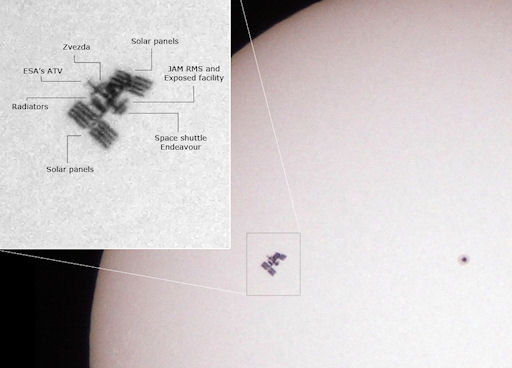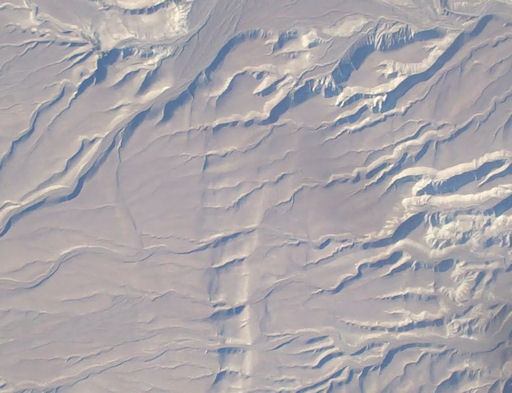Are we alone? Your iPhone has the answer. Download the all-new Drake Equation app to calculate the population of the Milky Way. | | |
QUIET SUN: Solar activity is very low, with no strong flares or geomagnetic storms expected for the next three days.
FLYBY FLURRY: In recent days, the quiet face of the sun has provided a nice backdrop for activity of a different sort--a flyby flurry. Observers in Europe have photographed multiple transits of the International Space Station and space shuttle Endeavour across the solar disk. This specimen obtained yesterday comes from Alex Conu of Furculesti, Romania:

"This was the second ISS transit I observed in less than a week," says Conu. "There could have been a third, but I was just too busy to watch one of them. The details we can see in the silhouette of the docked spacecraft are just amazing."
Astrophotographers who wish to take this kind of picture themselves can find daytime transit predictions at Calsky.org. Of course, seeing the ISS at night is wonderful, too. Flyby times may be found on your cell phone.
more silhouettes: from Maximilian Teodorescu of Bucharest, Romania; from Tamas Ladanyi of Veszprem, Hungary; from Mihai Curtasu & Vlad Dumitrescu of Furculesti, Roumania; from Vlad Dumitrescu of Alexandria, Romania; from Riccardo Rossi of Terrazzo (VR), ITALY; from Riccardo Rossi of San Biago (MO), ITALY
NAME THAT PLANET: Look at this picture. Can you identify the planet? Hint: It's not a gas giant. (continued below)

It's Earth. A group of high school students in Bishop, California, took the picture on May 20th using a high-altitude weather balloon. At the time of the snapshot, the balloon was drifting approximately 6 miles above the Death Valley National Park. That part of our planet has such an alien quality, you could easily be fooled into thinking you are looking at another world.
The flight was part of an ongoing project led by Dr. Tony Phillips to develop an inexpensive research platform for amateur scientists and student experimentors. The balloon can travel to the top of Earth's atmosphere, at the edge of space itself, where the air temperature and density and radiation environment are akin to that on the planet Mars. Eventually, readers of spaceweather.com will be invited to suggest experiments and apply for payload space onboard future flights. We're just getting started. Meanwhile, please browse selected images from our maiden voyage on May 20th: Liftoff, Bishop CA, River and Clouds, White Mountains, Weird Terrain, Owens River, Cobalt Sky, Above the Clouds, Eureka Dunes, Touchdown.
April 2011 Aurora Gallery
[previous Aprils: 2010, 2009, 2008, 2007, 2006, 2005, 2004, 2003, 2002]

